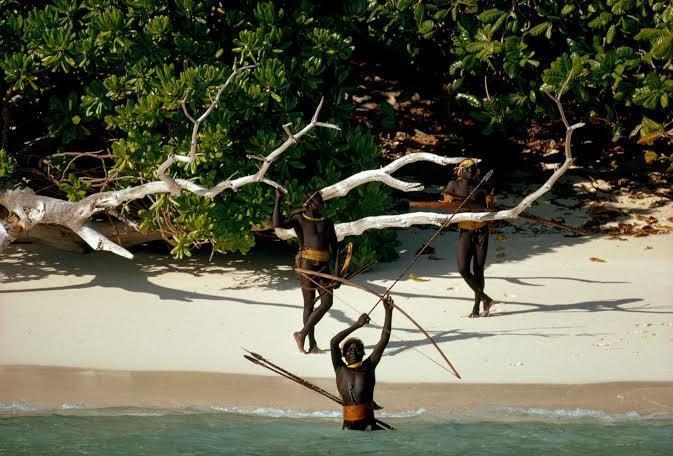The Indian Ocean looks endless from the deck of a patrol boat: a shifting sheet of blue, the horizon trembling in heat. Somewhere within that vastness sits a smudge of green—North Sentinel Island—where an entire people have perfected a single word for the modern world: no. For generations, the Sentinelese have met approaching boats with raised bows, turned helicopters away with a hail of arrows, and refused every gift, road, and promise the outside world has tried to deliver. They are not a curiosity. They are a nation—small, sea-ringed, and decided.
In early April 2025, that refusal made headlines again when Indian authorities arrested Mykhailo Viktorovych Polyakov, a 24-year-old American who slipped ashore with a coconut and a can of Diet Coke, filmed for minutes, and left. His “adventure” ended in custody, not catastrophe—thanks more to luck than wisdom. Indian officials were blunt: this was not an eccentric travel vlog; it was a violation of law that could endanger a people who want to be left alone. The GuardianCBS News
A Small Island, a Long Memory

North Sentinel is a thumb-sized forest (about 60 square kilometers) in the Andaman and Nicobar archipelago, roughly 1,200 kilometers from mainland India. The Sentinelese live by the reef and the trees—hunting, fishing, gathering—moving through mangroves and beaches with a confidence that comes from deep time. Scholars cautiously suggest their ancestors may have reached these islands tens of thousands of years ago, part of early migrations along the Indian Ocean’s rim. Whatever the exact timeline, the present tense is clear: they have thrived for a very long time without us. Wikipediasurvivalinternational.org
We do not know their language. We do not know the names they give themselves, their seasons, or their gods. What we can see—from distant boats and rare aerial images—is a community that appears healthy and self-sufficient, expertly adapted to an island they understand far better than any outsider. That is enough to justify caution. It should be enough to command respect. survivalinternational.org
How Do You Stay Uncontacted in a Connected World?

Geography helps. Shallow reefs ring North Sentinel; surf breaks on the outer bar; shoals shift after storms. Landing is hard even for professionals in good weather. History helps, too. Past intrusions—colonial “expeditions,” fishing trespass, voyeuristic tourism—taught the Sentinelese that strangers bring danger. Bows and distance became a rational policy. And then there is law: the Andaman and Nicobar Islands (Protection of Aboriginal Tribes) Regulation, 1956 (ANPATR) designates North Sentinel as a Tribal Reserve and forbids unauthorized approach. Today, India enforces a five-nautical-mile exclusion zone with naval and coast-guard patrols. The law exists for two reasons: to defend the Sentinelese sovereign choice to avoid contact, and to protect them from pathogens to which they have little or no immunity. Ministry of Home AffairsNature
The media rules are strict as well. In 2017, the Andaman administration reminded the public that photographing or posting images of protected tribes is a crime, punishable by imprisonment under amended tribal-protection and anti-atrocity laws. The aim is not secrecy for secrecy’s sake; it’s to choke off “human safaris” and the online attention economy that turns private lives into viral spectacle. Press Information Bureau
What We Know (and Don’t)

Most reliable information comes from observations at a distance. The Sentinelese build small outrigger canoes for lagoon waters, fish the shallows, hunt in the forest, and craft bows, arrows, and tools from island timbers and scavenged metal. Population estimates are guesses—small enough to be vulnerable, large enough to sustain a living culture. The most honest sentence any writer can produce about their language, politics, and religion is the simplest: we don’t know. That ignorance is not a failure; it is the Sentinelese exercising the right to privacy at a civilizational scale. survivalinternational.org
The Long Shadow of Contact
Contact with outsiders has rarely been benign. In the late 19th century, the British colonial officer M.V. Portman landed with a retinue “in the interest of science,” abducted an elderly couple and four children, and watched the adults die in Port Blair. The survivors were returned with gifts—and a reinforced lesson that strangers mean sickness and sorrow. Later “gift-dropping” expeditions by Indian officials in the 1970s–90s occasionally reached a wary détente (coconuts accepted from the shallows), but by 1996 the government abandoned the experiment as ethically and practically unsound. Law replaced outreach; patrols replaced curiosity. Wikipedia
Even disaster response confirmed the logic of distance. After the 2004 Indian Ocean tsunami, a navy helicopter flew over North Sentinel to check on survivors. A Sentinelese man stepped onto the sand, drew his bow, and fired an arrow at the hovering machine—a plain reply to an unasked question. They did not want help. They did not need it. The photograph became an emblem of a people’s hard-won autonomy. survivalinternational.org
Not all intrusions were avoidable. In 2006, two Indian fishermen drifted into forbidden waters after their boat slipped anchor at night. Sentinelese killed both men; the state did not prosecute, recognizing both the legal reality of the reserve and the impossibility of imposing outside criminal codes on an uncontacted community. It was tragedy, not mystery. It also underscored why the exclusion zone exists. The Guardian

The most widely reported violation came in 2018, when American missionary John Allen Chau paid local boatmen to smuggle him ashore to preach Christianity. He wrote in his diary of fear and faith; the Sentinelese answered as they had answered for centuries. He died on the beach. Indian authorities arrested those who aided him but did not attempt to retrieve his body, to avoid further exposure to the community. The episode ignited a worldwide debate about missionary work, consent, and the right of uncontacted peoples to reject us. TIMEThe Guardian
In 2025, Polyakov’s brief landing replayed the same arguments in the language of social media and content creation. Police said it plainly: call it “adventure” if you like, but it breaks Indian law and risks lives—the Sentinelese first and foremost. He was remanded to custody; the video evidence was enough. If there is a lesson, it is that deterrence must be relentless, because curiosity is, too. CBS NewsHindustan Times
Why Non-Contact Isn’t Cruelty
To outsiders, a five-mile legal moat can look like a gilded cage. But non-contact is a public-health policy as much as a moral one. Uncontacted peoples lack immunity to common respiratory and gastrointestinal diseases that outsiders shrug off. History—from the Amazon to the Pacific—shows that first contact often means first epidemics, with mortality that can shatter a society in a single season. In plain terms: a handshake can be a weapon; a well-meaning gift can be an infection vector. That is why India’s prohibition on approach, landing, photography, and trade is not paternalism. It is harm reduction. It is also law. NaturePress Information Bureau
Equally important is agency. The Sentinelese have said “no” not once but repeatedly, across decades and to every kind of visitor: colonial official, scientist, tourist, missionary, YouTuber. That consistency is a political fact. We do not require a transcript of their debates to recognize a collective decision. When a people unambiguously declines contact, the ethical response is to honor the decision—especially when our presence carries biological risk. survivalinternational.org
The Law as a Living Perimeter

India’s framework has three pillars:
-
Territorial status: North Sentinel is notified as a Tribal Reserve under ANPATR 1956; entry, stay, or overflight for contact is prohibited without special authorization. Ministry of Home Affairs
-
Stand-off distance: Approaches within five nautical miles (≈9.26 km) are forbidden to prevent accidental beachings and casual encounters. Nature
-
Media and exploitation controls: Publishing images or organizing tours involving protected tribes can attract criminal penalties; “human safaris” are explicitly targeted. Press Information Bureausurvivalinternational.org
These are backed by active patrols in surrounding waters. The rules are not fence posts in a forgotten field; they are enforced and—crucially—publicized, so would-be thrill seekers cannot claim ignorance. Nature
What About “Learning” From Them?
Scholars sometimes argue that every society has insights worth sharing—ecology, kinship, resilience. That may be true. It is also beside the point. The Sentinelese are not a dataset waiting to be downloaded; they are neighbors with a closed door. Respect does not require comprehension. Support does not require interviews. Researchers concerned with their well-being can—and do—monitor from a distance, lobby for stronger enforcement, and work to suppress the incentives (resource theft, attention-seeking virality) that drive intrusions. Press Information Bureau
The Photo That Changed the Conversation
If there is a single image that explains the modern compact between India and North Sentinel, it is that 2004 frame: a lone figure on the beach, arrow drawn, pointing at a hovering helicopter. Many saw menace; many more saw clarity. The tsunami had scoured shorelines across the region. Aid poured in. But on this island, rescue would have been violation. The arrow, paradoxically, delivered relief—to the Sentinelese, by preserving their autonomy; and to the rest of us, by reminding us there is dignity in refusing help we did not ask for. survivalinternational.org
The Temptation of the Forbidden
Why do people try anyway? Some chase God. Some chase views. Some are stirred by a romantic idea of “first contact.” But those motivations collapse under scrutiny. Missionary zeal disregards consent and carries disease. Influencer stunts turn people into backdrops. Even scientific curiosity, when it crosses the surf, stops being science and starts being trespass. The Sentinelese do not need converts, content, or case studies. They need the sea around them to remain a buffer and the law behind them to remain unbending. GQCBS News
What “Leaving Them Alone” Actually Means
It does not mean neglect. It means funding patrols, prosecuting traffickers and fixers who sell illegal boat rides, and refusing retrieval missions that would multiply risk. It means education and deterrence aimed at travelers who confuse other people’s lives with their own adventures. It means the press resisting the urge to publish coordinates, recognizable imagery, or sensational narratives that invite copycats. And it means accepting uncertainty as a feature, not a bug, of a just world. Some things we are not meant to know. Some doors we are not meant to open. Press Information Bureau
Conclusion: A Different Kind of Progress
Modernity often measures progress by contact—roads built, markets opened, stories shared. North Sentinel offers a different measure: a community that has decided the cost of contact is greater than the value. The Sentinelese are not “lost” or “left behind.” They are exactly where they choose to be, and the rest of us are the ones who must change course.
So the boats turn away. The patrol wakes trace a white seam over blue water and vanish. In the forest, life goes on—spearfishing at dawn, cooking fires in the lee of the palms, the rhythms of a society that has nothing to sell and nothing to buy. The island remains a green dot in a blue world, saying the oldest sentence any people can say to another: we will be ourselves. Our answer—written into law and, when necessary, spelled out in court dockets—should continue to be just as old, and just as clear: we hear you. Ministry of Home AffairsNature
Sources
-
Legal & policy: Andaman & Nicobar Islands (Protection of Aboriginal Tribes) Regulation, 1956 (as amended); stand-off rules (5 nmi); 2017/2018 guidance on photographing tribes. Ministry of Home AffairsNaturePress Information Bureau
-
Recent case: Arrest of Mykhailo V. Polyakov (April 2025). The GuardianCBS NewsHindustan Times
-
2004 tsunami overflight & photo: Indian Coast Guard / Survival International. survivalinternational.org
-
2006 fishermen deaths: Contemporary reporting and analysis. The Guardian
-
2018 John Allen Chau: Time; The Guardian. TIMEThe Guardian
-
Background & observation: Survival International dossier; general overviews.
